Thanksgiving Reflections: Why Iowa’s Warming Winters Are a Warning We Can’t Ignore
Fewer Snowstorms, Bigger Problems: How Climate Change Is Reshaping Iowa’s Winters and What It Means for Us All
As we gather with friends and family this Thanksgiving, I want to take a moment to express my heartfelt gratitude to each of you - both free and paid subscribers.
Your interest in climate change, your willingness to stay informed, and your engagement with the work I share means more than I can say. It’s easy to feel overwhelmed by the challenges we face, but knowing there’s a community of thoughtful, curious, and passionate people out there gives me hope.
Together, we’re making the conversation around climate change more accessible, urgent, and impactful. Whether it’s through reading, sharing, or supporting this platform, your commitment to understanding and addressing this critical issue is a step toward a better, more sustainable future.
With three days of meteorological fall remaining, it is the 2nd warmest and 43rd driest fall on record in Des Moines. There is one month left of 2024 and currently it is the fourth warmest year on record. Out of the top 10 warmest years on record, 5 have occurred since 2000 (the data set started in 1873). This isn’t a local trend; it’s a global trend. There is now a >95% chance that 2024 will be the hottest year on record, knocking 2023 from the top spot.
As we flip the calendar from fall to winter, average temperatures have skyrocketed since 1970. In Des Moines, the average temperature during the winter has increased by a staggering 5°F. You can see the trend across Iowa by clicking through the images.
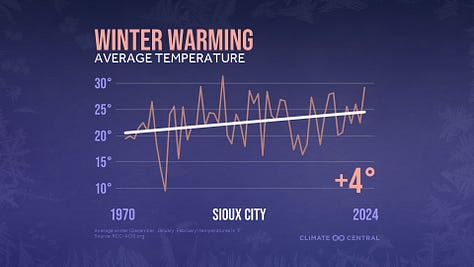
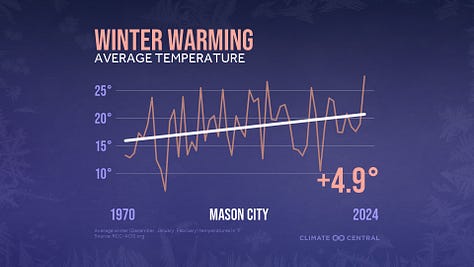
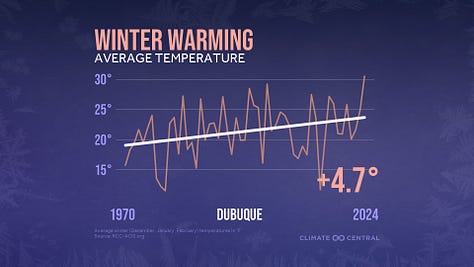
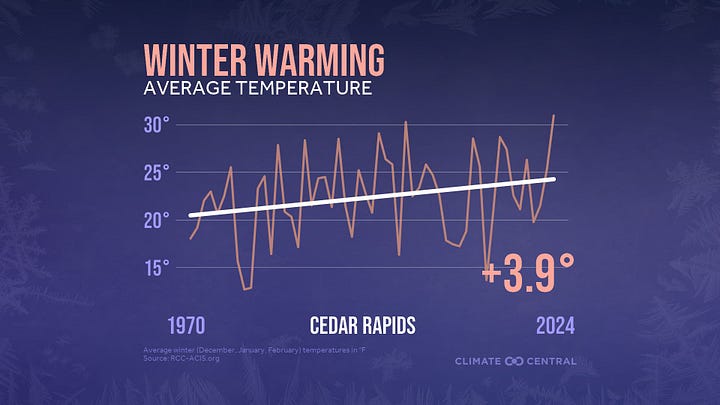
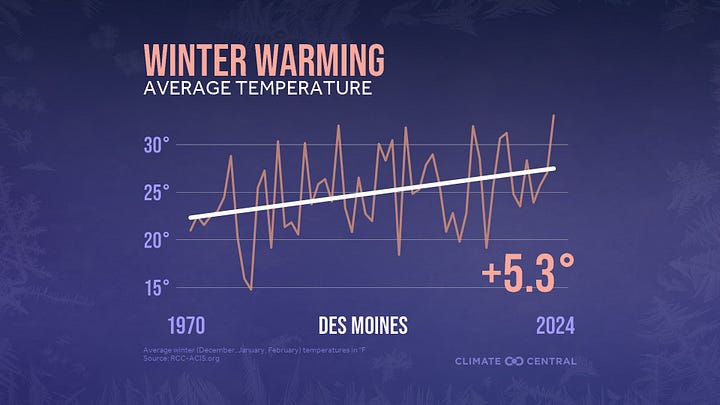
Why Warming Winters Are Bad News for Iowa
As temperatures climb globally, the effects of warming winters are becoming increasingly evident in Iowa. While fewer frigid days might sound like a welcome reprieve to many, the reality is that this shift brings significant challenges to our environment, economy, and way of life. Let’s explore why warmer winters aren’t the silver lining they might seem.
1. Increased Pest Survival
Cold winters serve as nature’s pest control. Insects like the emerald ash borer, corn rootworm, and soybean aphid are typically kept in check by Iowa’s freezing temperatures. Warmer winters allow more of these pests to survive and thrive, leading to greater pressure on crops, forests, and native ecosystems. This means higher costs for farmers and homeowners alike, as more resources are spent on pest management.
2. More Extreme Weather Events
Warming winters don’t mean consistent, mild weather. Instead, they often result in more erratic patterns, such as rapid freeze-thaw cycles. These cycles can damage infrastructure, causing potholes, cracks in roads, and stressed water systems. Ice storms, which are more likely with fluctuating temperatures, also pose significant hazards, disrupting travel, power, and daily life.
3. Threats to Agriculture
Iowa’s agriculture depends on predictable seasonal changes. Warmer winters can lead to earlier thawing and planting, which might seem advantageous at first. However, this can increase the risk of frost damage to crops if cold snaps return unexpectedly. Additionally, pests and diseases that typically overwinter farther south may expand their range into Iowa, compounding the challenges farmers face.
4. Ecological Imbalances
Many species native to Iowa are adapted to its traditional cold winters. Warmer conditions can disrupt these ecosystems, favoring invasive species and altering food webs. For instance, snow cover, which insulates the ground and provides habitat for certain species, may decrease, affecting everything from soil health to wildlife survival rates.
5. Greater Public Health Risks
Warmer winters can exacerbate public health issues. Tick-borne diseases, like Lyme disease, may become more prevalent as warmer winters expand tick habitats. Similarly, milder conditions could extend allergy seasons, leaving more people suffering for longer periods.
6. Water Management Challenges
Iowa’s snowpack is an essential part of its water cycle, gradually replenishing rivers and groundwater as it melts. With warmer winters, more precipitation may fall as rain instead of snow, leading to higher risks of winter flooding and reduced water availability during the growing season.
Looking Ahead
Warming winters are a reminder that climate change doesn’t always show up as dramatic hurricanes or scorching summers - it’s also in the subtle shifts that disrupt the balance we depend on.
In Iowa, these warmer winters serve as a wake-up call. They’re a sign of changes happening faster than many of our systems - natural or human-made - can adapt. While it’s tempting to focus on fewer snowstorms and lower heating bills, the long-term consequences demand attention and action.
Thank you for being part of the conversation and for caring about the impact of climate change on our communities. Together, we can advocate for solutions that protect Iowa’s future.
Here is a list of our current membership. Please follow along:

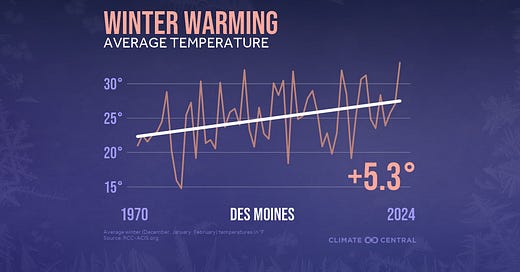


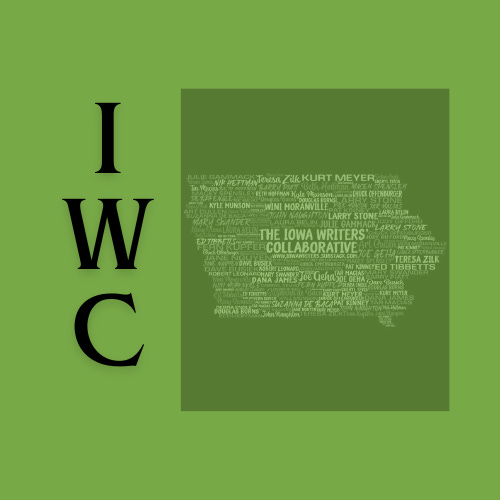
Thanks, Chris, for the easily understood data and the concise summary of the climate change implications. Keep informing us; it'll take time for us to grasp what's happening and bestir ourselves to confront it.
A great reminder! Given these reminders, what are the top three actions we (Iowans) can do this Thanksgiving to "work for change?"